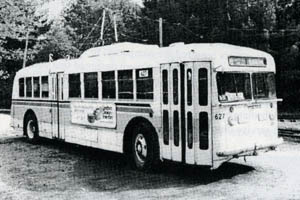
- Builder
- Twin Coach
- Description
- Model 41GWFT
- Secondary Use
- None
- Type
- Trackless Trolleys
- Year
- 1940
- Retired from Service
- 1978
- Acquired by the Museum
- 1983
- Note
- No. 627 is believed to not be operational.
- Fund
- 843
Seattle Transit Commission 627
From Seattle, Washington
History
In 1940, Seattle replaced its entire system of streetcars and cable cars with trolley buses and a smaller number of motor buses. Seattle became the largest U.S. city without streetcars at that time. It was also the only city at that time where trolley buses formed the backbone of its transit system. Operation was by the newly formed Seattle Transit System under an independent commission. Seattle’s initial trolley bus fleet consisted of 100 trolley buses built by Pacific Car & Foundry under license from Brill and 135 trolley buses (Nos. 800 - 934) built by Twin Coach Company of Kent, OH. The system acquired 72 more trolley buses from Twin and Pullman-Standard in 1942-1944, bringing the total fleet to 307 coaches. The vehicles came in with a flashy cream and two-tone green paint scheme. The trolley buses saw heavy use during World War II and again during the 1962 World’s Fair in Seattle. In 1952, the system was reorganized as the Seattle Transit Commission. After the 1962 Fair, Seattle converted many trolley bus routes to motor buses. In 1964, the remaining Twin coaches from 1940 were renumbered 600 – 659. No. 867 became No. 627. Seattle’s total trolley bus fleet shrunk to about 50 coaches by 1970.
Seattle had not purchased any new trolley buses since 1944. Some Seattle residents agitated to retain and expand the trolley bus system. In 1971, consultants hired by the commission studied the merits of trolley buses compared with motor buses. The consultants ran tests comparing a 1969 V-8 motor bus built by General Motors with trolley bus No. 627, which, by then, was old and worn out. The consultants recommend retaining the trolley buses in spite of the extra costs of overhead wire maintenance because of the trolley’s performance on Seattle’s steep hills. No. 627 operated at 20 mph up a 14 percent grade, but the diesel reached only 16 mph; on the 18 percent Queen Ann hill, the trolley reached 18 mph but the diesel could not exceed 9 mph. The diesel also required “excessive braking” on the downhill.
In 1973, the Municipality of Metropolitan Seattle took over operation from the commission. The new operator, King County Metro Transit and known usually as “Metro,” adopted a new policy of retaining and expanding the trolley bus network. The old coaches continued running until 1978 when the Metro retired all of the old vehicles and installed new trolley buses, new overhead wire and a new power distribution system. Seattle has since expanded its trolley bus system, making it the second largest in the U.S. after San Francisco.
In 1980, Seattle’s Metro donated No. 627 to Seashore. It remained in storage at a private yard in Seattle until Seashore trucked it to Maine at the end of 1983. Volunteers did some cosmetic restoration after No. 627 arrived. Seashore’s No. 627 can claim to be the vehicle that helped save trolley bus service in Seattle.
Technical Information
- Seats: 41
- Control: XC (423L)
- Brakes: Straight Air
- Tires: 11x22
Motor
- Number: 1
- Manufacturer: Westinghouse
- Model: 1442
Weight and Dimensions
- Length: 35’
- Width: 8’ 5.00"
- Height: 10’
- Weight: 21500 lbs.
© 1998 - 2026 New England Electric Railway Historical Society. All Rights Reserved.